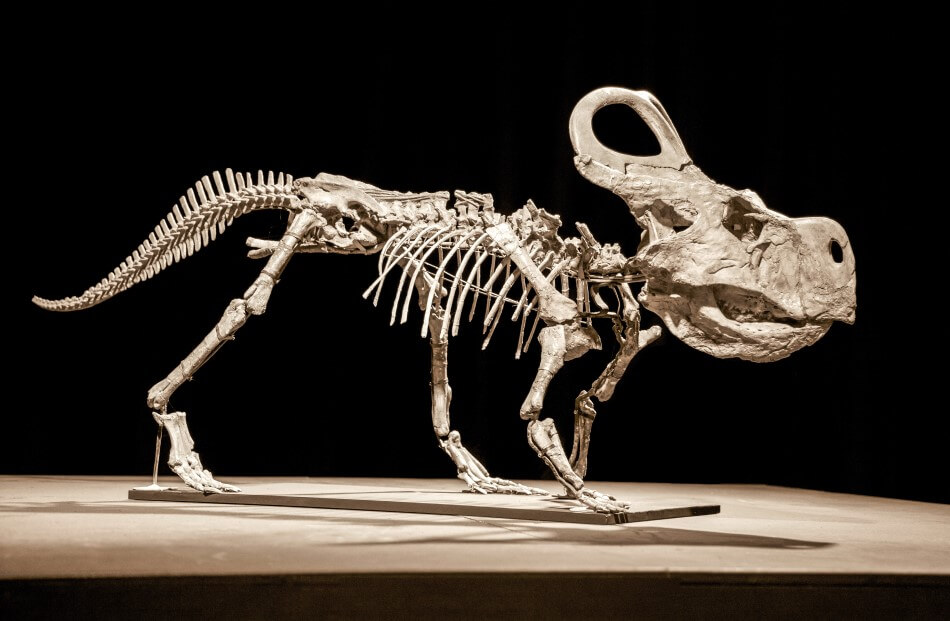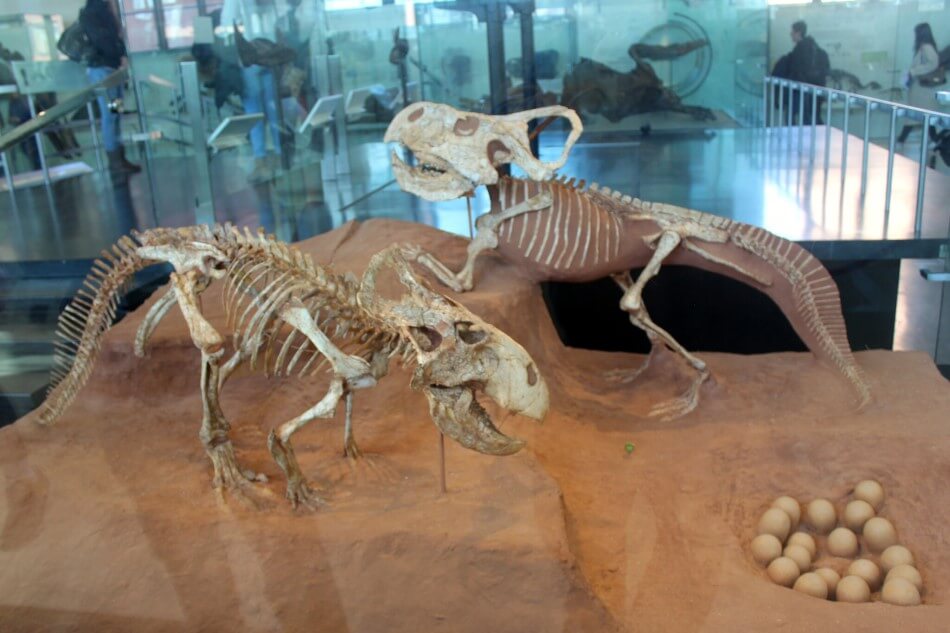Protoceratops (said pro-toe-seh-rah-tops) was a four-legged herbivorous, or vegetarian, dinosaur which lived in the late Cretaceous period, around 75–70 million years ago. It was found in central Asia, alongside ferocious predators such as the infamous Velociraptor.
Protoceratops means ‘first horned face’ in Greek, but it was certainly not the first of its kind, called ‘ceratopsians’. Also, Protoceratops’ skull consisted of a bird-like beak and a large, bony collar, but definitely no horns! So, the name may not quite fit the image and, undeniably, Protoceratops wasn’t the most dangerous of dinosaurs, or even the most dazzling.
But, it is famous in its own way, and that’s for bravely battling a vicious Velociraptor hungry for his lunch over 70 million years ago! But how do we know that? Read on to find out the answer and even more fascinating Protoceratops facts.
1. Protoceratops was the size of a family pet.
It was actually quite a small dinosaur, just 1.8m or 6ft long, and about 0.6m or 2ft high. But, Protoceratops’ size was deceptive – it weighed in at a hefty 180kg, that’s 400lb – the same as a pygmy hippo. So, although only about the size of quite a large pet dog, having this chunky little chap stand on your feet at dinnertime would be a lot more painful!
2. Protoceratops’ had a herbivorous diet.
Protoceratops’ diet was strictly vegetarian, and it was physically adapted to eat plants, making it a herbivore. It used the claws on its stumpy front legs to dig through undergrowth for twigs or leaves and reached up to snip low hanging branches, or maybe some newly evolving Cretaceous angiosperms (flowering plants), with its sharp beak.
3. The habitat for a Protoceratops was originally thought to be swamps and forests.
Until the 1920’s, palaeontologists (that’s fossil scientists) thought that all dinosaurs lived in swamps and forests. However, the discovery of Protoceratops’ eggs fossilised in sandy pits in desert areas of China and Mongolia proved that theory wrong. What’s more, the eggs had patterns and small pores on their shell, convincing scientists that they were adapted for desert survival.

4. The first ever Protoceratops fossilised skeleton was discovered in 1922 on an expedition funded by the American Museum of Natural History.
Leading the expedition was famous fossil hunter, Roy Chapman Andrews, who gave his name to the species making its official title, Protoceratops andrewsi. The trip to uninhabitable and unknown Mongolia as it was then, led to a huge discovery by Andrews’ team in the Gobi Desert which covers parts of China too. There were massive numbers of Protoceratops eggs, fossils and, as a bonus, the additional discoveries of Velociraptor, Oviraptor and Psittacosaurus, a genetic ancestor of Protoceratops.
5. The discoveries of hundreds upon hundreds of eggs and fossils all together in pits and piles in different locations has enabled scientists to deduce that Protoceratops lived in large packs, or herds.
This was probably a security measure to help protect these relatively helpless dinosaurs from their numerous apex predators – safety in numbers to the extreme!
6. Scientists believe that Protoceratops were doting parents.
Studies have shown that Protoceratops were, despite their rather off-putting appearance, caring and loving parents to large batches of eggs and offspring. A nest discovered in 2011 contained 15 baby Protoceratops, all around one years old. This has indicated that babies were nurtured and cared for by their parents for far longer than most animal parents, excluding humans, do.
7. Protoceratops had huge eyes for a dinosaur, which we can tell from the skulls that have been found.
Initially, it was thought that its big eyes meant that Protoceratops was nocturnal, but more recent research focusing on the bones surrounding the eye socket in Protoceratops’ skull has now led experts to believe that it was actually cathemeral, that’s active both during the day and during the night.
8. Protoceratops’ skull was huge.
The frill covering the vulnerable neck of the Protoceratops was very heavy. It was actually part of the Protoceratops’ skull, starting where the jaw muscles would have attached and sometimes extending right back past the neck joint. In some Protoceratops, this bony shield was quite modest. But others, particularly the males, were found to have much larger and more elaborate collars which scientists think may have been used as protection from predators and for attracting females. A thick, heavy tail helped to balance this heavyweight head, as did some very strong neck muscles, but Protoceratops’ super skull made it a slow and cumbersome runner, nearly perfect prey for its nimble-footed predators.

9. They had a bird-like beak, and teeth too!
Protoceratops had a beak just like a bird. But, unlike modern day birds, it also had teeth! The distinctive beak was extremely sharp and well suited for Protoceratops’ diet, being ideal for clipping branches and low-hanging leaves. It could also give a very nasty nip when the need arose. Behind its horny beak, Protoceratops sported rows of leaf-shaped teeth, ideal for grinding down vegetation and branches.
10. the poor Protoceratops had its fair share of predators out to make it into their lunch.
The well-known, vicious Velociraptor and the bird-like Oviraptor lived at the same time as Protoceratops and are known to have been its main marauders. In fact, the fossilised skeleton of an Oviraptor with its skull crushed was found in the sand above a Protoceratops’ nest full of eggs. A sure sign that this infamous little egg-stealer was a problem for the entire herd of Protoceratops families.
11. Protoceratips sizes differed between sexes.
The average Protoceratops’ size was similar to that of a short, dumpy pony. However, fossil skeletons have shown differences in this size which can be linked to the sex of the dinosaur, which is whether it was male or female. Males were generally larger and were found to have a larger frill or collar and a larger bump on their snout or nose, which some researchers feel could have been the beginning of a horn.
12. Protoceratopsian eggs were soft-shelled and, unfortunately, a tasty snack for some.
However, many have been preserved and fossilised and are a valuable source of information for palaeontologists in their search for Protoceratops facts. Older infant skeletons have also progressed studies and scientists in 1997 were able to confirm how and when young Protoceratops began developing their fantastic frills.
13. Greek writers may have confused the Protoceratops with a Griffin.
Thousands of years ago, in the 7th century B.C., Ancient Greek writers began documenting rumours of a fantastical beast with the body of a lion and the head, wings and front legs of a bird of prey. This mythical monster is called a Griffin and a few scientists believe that the Greeks were actually writing based on the tales of Scythian nomads who travelled the sands of the Gobi Desert. These nomads could easily have come across the fossilised skeletons of herds of Protoceratops with their bird-like beaks and mammalian body shape. Or maybe a herd of Griffins?
14. In 2001, a new type or species of Protoceratops was named.
Protoceratops Hellenikorhinus was discovered in Inner Mongolia and was different to Ray Andrews’ Protoceratops Andrewsi. Palaeontologists found that these newer fossils showed a much more developed horn on the beak of the Protoceratops’ skull and some differences in the fronto-palatial depression, that’s a small dip, at the top of the beak.
15. So, how do we know a Protoceratops bravely fought a Velociraptor?

The presence of Velociraptor and Oviraptor fossils in Protoceratops’ nests alongside eggs and babies was a fabulous find for Roy Andrews in 1922 and led to more and more digs and discoveries all around Central Asia. However, with all of the information obtained from these digs, perhaps the most important and conclusive find happened in 1971 in Mongolia.
Dinosaur hunters discovered the fossilised remains of a Protoceratops and a Velociraptor locked in a gruesome battle to the death. These famous fossils, named the ‘fighting dinosaurs’, were evidence of the predator-prey relationship of Protoceratops and Velociraptor and came about when the two battling beasts were caught in a sandstorm and captured in time in their last act. The specimen also suggests that, interestingly, Velociraptor was not on the winning side at the time.
The Importance of Protoceratops
So now you know more about this stumpy socialite of the Cretaceous period, Protoceratops. Although it hasn’t had a starring role in any of the Jurassic Park movies and isn’t a huge presence in the dinosaur world, these Protoceratops’ facts show that, to palaeontologists and fossil hunters around the world, this front-heavy herbivore is much more important than it first seems.
Protoceratops FAQs
What did Protoceratops eat?
Protoceratops was a herbivore, meaning they ate plants. It used the claws on its stumpy front legs to dig through undergrowth for twigs or leaves and reached up to snip low hanging branches.
What is the Protoceratops known for?
Protoceratops was a small, stumpy dinosaur that was hunted by many other carnivorous dinosaurs, such as the velociraptor. However, various fossils have been discovered showing the Protoceratops locked in battle, so it was no pushover!
How big was a Protoceratips?
The Protoceratops was actually quite a small dinosaur, just 1.8m or 6ft long, and about 0.6m or 2ft high. But, Protoceratops’ size was deceptive – it weighed in at a hefty 180kg, that’s 400lb – the same as a pygmy hippo.
How did Protoceratops get its name?
Roy Chapman Andrews discovered the Protoceratops in 1922, and gave his name to the species, making its official title Protoceratops andrewsi. Protoceratops means ‘First Horned Face’ in Greek.
Was the Protoceratops fast?
Scientists believe that the Protoceratops was a slow dinosaur. While on the smaller side, they were very heavy and had stumpy legs.
